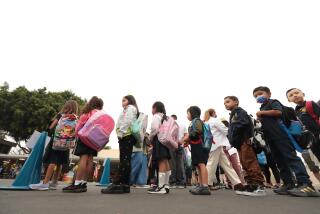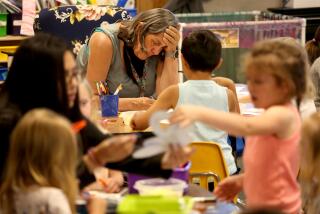Opening Up the Classroom : Education: The Conejo Valley Unified School District considers a program that allows students to learn at their own pace.
- Share via
Berta Hurley of Newbury Park drives her sixth-grade son, Ryan, to Ventura each day so that he can attend an “open classroom,” which is not available in her own community.
Ryan, 12, diagnosed as a dyslexic, was having difficulty in his classes at Manzanita and Banyan elementary schools, despite some excellent teachers, his mother said.
So she sought an alternative education and enrolled him at Blanche Reynolds School in Ventura.
“For his own emotional state of mind, he couldn’t compete in the regular classroom,” she said. “He’s smart enough to realize he can’t do the same things as other children.”
Ryan’s open classroom, based on a philosophy of letting him and his classmates learn at their own pace, relieves him of that pressure. After a year at Blanche Reynolds, Ryan has become excited about going to school. The experience, Hurley said, has led her to seek a similar program in the Conejo Valley Unified School District.
Her quest, which has mushroomed into an organized campaign by parents throughout the Thousand Oaks area, faces a critical test Thursday, when the Conejo Valley Unified School District board decides whether to establish an open classroom program.
The parents--who call themselves Choice for Open Individual Classroom Education, or CHOICE--have already hit a stumbling block. District Supt. William Seaver, citing primarily financial considerations, is advising the board to reject the CHOICE proposal.
“The thing I have the greatest concern about now is we’re looking at a $3-million deficit next year,” Seaver said. “We’re looking at some serious cuts. The timing could not have been worse for this proposal.”
State law allows any parent to request school boards to establish an alternative school program. In Conejo Valley, the parents of 140 children have so far expressed an interest in enrolling their children in an open classroom program, Hurley said.
The Thousand Oaks parents are seeking four open classes, either at an existing school or in vacant classrooms in the former Horizon Hills campus, for about 125 students in kindergarten through eighth grade.
CHOICE parents say the open classroom, which has existed in various forms for the past 40 years in England and 20 years in the United States, provides a less structured learning environment than traditional classes, an integrated curriculum and more hands-on learning. Parent participation is a key element of open classrooms, which are now offered in more than 500 schools in California cities, including Los Angeles, San Francisco, Ventura and Camarillo.
“We don’t teach math at 9, English at 10 and social studies at 11,” said Jock Scott, open classroom teacher at Blanche Reynolds. Instead, he said, students are given a broad topic--such as Africa--and read folk tales, conduct research, write and do math and other subjects related to it.
In addition, the curriculum is geared more to the individual student’s abilities.
“So, if a fourth-grader is capable of third-grade work, that’s what we have them do,” said Scott, who has taught in traditional programs. “If a fourth-grader is capable of sixth-grade work, that’s what we have them do.”
On a typical day, Scott said, one to four parents will help out in his second- through sixth-grade class. Some will work as aides, some will give guest lectures, some will raise funds for class projects while others will find books and various other resources.
“There’s more of a family atmosphere,” he said.
Advocates believe that most children benefit from such a program.
“The gifted students are able to go as fast as they want,” Hurley said. “The learning-disabled student is able to be accepted by peers for his contribution to the class without having to compete. The average student is able to learn in a supportive environment that fosters trust.”
Hurley said her son has blossomed in the open classroom. “He’s still having difficulty reading,” she said, “but he’s not afraid of risking.”
On Tuesday, officials in the Ventura Unified School District received a proposal from a committee of parents, teachers and administrators to expand Blanche Reynolds’ program to include seventh-grade students next year and eighth-graders the year after that.
The Ventura school board is scheduled to vote on the proposal at a March 26 meeting.
The parents say the open classroom of the ‘90s is far different from the alternative programs that many districts offered in the ‘60s and ‘70s.
“One of the differences in the courses of the ‘60s and now is that then, a child could sit and do nothing,” said Lori Mahoney of Thousand Oaks, one of the CHOICE parents. “Now, that would be unacceptable. You’re not free to choose to watch the sunset.”
“It was a failed program from the ‘70s,” Hurley said, “only because it was not presented properly. Teachers didn’t have any background in that kind of education. It was new in this country.”
Officials at Blanche Reynolds, which has had an open classroom program since the mid-’70s, said no formal studies have been conducted on the academic performance of their open classroom pupils compared to their counterparts in traditional settings. Unofficial tracking indicates that the two groups seem to perform at about the same level, Scott said.
In a report to the school board, Seaver stated that his primary objection to the program in Thousand Oaks is based on the projected cost.
The report estimated that the cost of establishing an open alternative school at Horizon Hills would be at least $350,000 for renovation and another $400,000 to $500,000 a year for personnel and other operational expenses. The latter figure includes an estimated $75,000 to $150,000 in potential loss of rental income, because the district had intended to lease all or part of Horizon Hills to help ease a projected financial crunch.
The report also estimated that the CHOICE proposal would generate about $80,000 a year from the state for students who would otherwise attend private or home-school programs. That is not enough to justify establishing a program “for relatively few students at a time when serious financial losses are resulting in the potential reduction of existing quality programs and services,” the report concludes.
More to Read
Sign up for Essential California
The most important California stories and recommendations in your inbox every morning.
You may occasionally receive promotional content from the Los Angeles Times.










